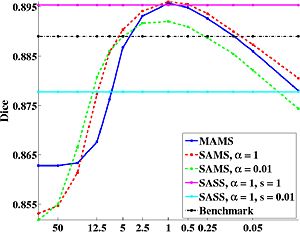Difference between revisions of "Projects:RegistrationRegularization"
| Line 40: | Line 40: | ||
* [http://www.na-mic.org/pages/Special:Publications?text=Projects%3ARegistrationRegularization&submit=Search&words=all&title=checked&keywords=checked&authors=checked&abstract=checked&sponsors=checked&searchbytag=checked| NA-MIC Publications Database] | * [http://www.na-mic.org/pages/Special:Publications?text=Projects%3ARegistrationRegularization&submit=Search&words=all&title=checked&keywords=checked&authors=checked&abstract=checked&sponsors=checked&searchbytag=checked| NA-MIC Publications Database] | ||
| − | [[Category: Registration]] | + | [[Category: Registration]] [[Category:Segmentation]] |
Revision as of 01:04, 8 April 2008
Home < Projects:RegistrationRegularizationBack to NA-MIC Collaborations, MIT Algorithms
We propose a unified framework for computing atlases from manually labeled data sets at various degrees of “sharpness” and the joint registration and segmentation of a new brain with these atlases. In non-rigid registration, the tradeoff between warp regularization and image fidelity is typically set empirically. In segmentation, this leads to a probabilistic atlas of arbitrary “sharpness”: weak regularization results in well-aligned training images, producing a “sharp” atlas; strong regularization yields a “blurry” atlas. We study the effects of this tradeoff in the context of cortical surface parcellation, but the framework applies to volume registration as well.
Description
In image registration, one usually optimizes the objective function with two parts. The first term is the similarity between images. The second term regularizes the warp. The smoothness parameter C that weights the second term determines the tradeoff between the similarity measure and the regularization.
In Atlas-Based Segmentation, one is given a set of labeled training images. The training images are co-registered to a common space. An atlas that summarizes the information between the image features and the labels is computed in this common space. This atlas is used to segment and normalize a new image.
In this study, we propose a unified framework for computing atlases from manually labeled data at various degrees of “sharpness” and the joint registration-segmentation of a new brain with these atlases. Using this framework, we investigate the tradeoff between warp regularization and image fidelity, i.e. the smoothness of the new subject warp and the srapness of the atlas.
We compare three special cases of our framework, namely:
(1) Progressive registration of a new brain to increasingly “sharp” atlases using increasingly flexible warps, by initializing each registration stage with the optimal warps from a “blurrier” atlas. We call this multiple atlases, multiple warp scales (MAMS).
(2) Progressive registration to a single atlas with increasingly flexible warps. We call this single atlas, multiple warp scales (SAMS).
(3) Registration to a single atlas with fixed constrained warps. We call this single atlas, single warp scale (SASS).
We use dice as the measure of segmentation quality. From the graph below, we note that the optimal parcellation algorithm in all three cases yield a statistically significant improvement over a state-of-the-art benchmark parcellation algorithm [1,2]. The optimal algorithms correspond to a unique balance between atlas “sharpness” and warp regularization. Our experiments show that the optimal parameter values that correspond to this balance can be determined using leave-out experiments. This optimal value seems to be robust across subjects, and the same for both co-registration of the training data and registration of a new subject. This suggests that a single atlas at an optimal sharpness is sufficient to achieve the best segmentation results.
Key Investigators
- MIT Algorithms: [| B.T. Thomas Yeo], Mert Sabuncu, Rahul Desikan, Bruce Fischl, Polina Golland
Publications
In Print


